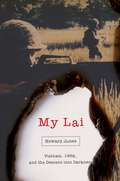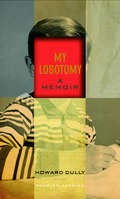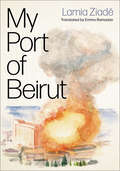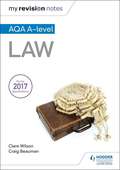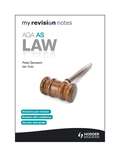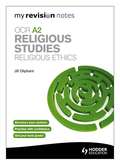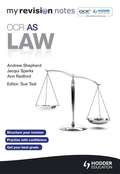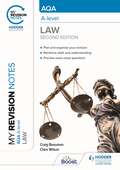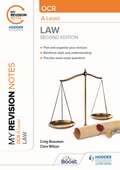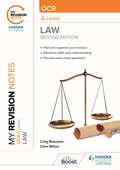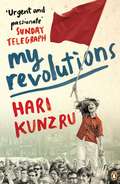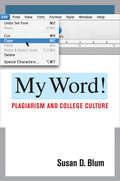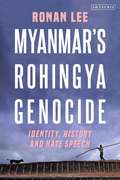- Table View
- List View
My Lai: Vietnam, 1968, and the Descent into Darkness (Pivotal Moments in American History)
by Howard JonesOn the early morning of March 16, 1968, American soldiers from three platoons of Charlie Company (1st Battalion, 20th Infantry Regiment, 11th Brigade, 23rd Infantry Division), entered a group of hamlets located in the Son Tinh district of South Vietnam, located near the Demilitarized Zone and known as "Pinkville" because of the high level of Vietcong infiltration. The soldiers, many still teenagers who had been in the country for three months, were on a "search and destroy" mission. The Tet Offensive had occurred only weeks earlier and in the same area and had made them jittery; so had mounting losses from booby traps and a seemingly invisible enemy. Three hours after the GIs entered the hamlets, more than five hundred unarmed villagers lay dead, killed in cold blood. The atrocity took its name from one of the hamlets, known by the Americans as My Lai 4. Military authorities attempted to suppress the news of My Lai, until some who had been there, in particular a helicopter pilot named Hugh Thompson and a door gunner named Lawrence Colburn, spoke up about what they had seen. The official line was that the villagers had been killed by artillery and gunship fire rather than by small arms. That line soon began to fray. Lieutenant William Calley, one of the platoon leaders, admitted to shooting the villagers but insisted that he had acted upon orders. An exposé of the massacre and cover-up by journalist Seymour Hersh, followed by graphic photographs, incited international outrage, and Congressional and U.S. Army inquiries began. Calley and nearly thirty other officers were charged with war crimes, though Calley alone was convicted and would serve three and a half years under house arrest before being paroled in 1974. My Lai polarized American sentiment. Many saw Calley as a scapegoat, the victim of a doomed strategy in an unwinnable war. Others saw a war criminal. President Nixon was poised to offer a presidential pardon. The atrocity intensified opposition to the war, devastating any pretense of American moral superiority. Its effect on military morale and policy was profound and enduring. The Army implemented reforms and began enforcing adherence to the Hague and Geneva conventions. Before launching an offensive during Desert Storm in 1991, one general warned his brigade commanders, "No My Lais in this division--do you hear me?" Compelling, comprehensive, and haunting, based on both exhaustive archival research and extensive interviews, Howard Jones's My Lai will stand as the definitive book on one of the most devastating events in American military history.
My Lai: Vietnam, 1968, and the Descent into Darkness (Pivotal Moments in American History)
by Howard JonesOn the early morning of March 16, 1968, American soldiers from three platoons of Charlie Company (1st Battalion, 20th Infantry Regiment, 11th Brigade, 23rd Infantry Division), entered a group of hamlets located in the Son Tinh district of South Vietnam, located near the Demilitarized Zone and known as "Pinkville" because of the high level of Vietcong infiltration. The soldiers, many still teenagers who had been in the country for three months, were on a "search and destroy" mission. The Tet Offensive had occurred only weeks earlier and in the same area and had made them jittery; so had mounting losses from booby traps and a seemingly invisible enemy. Three hours after the GIs entered the hamlets, more than five hundred unarmed villagers lay dead, killed in cold blood. The atrocity took its name from one of the hamlets, known by the Americans as My Lai 4. Military authorities attempted to suppress the news of My Lai, until some who had been there, in particular a helicopter pilot named Hugh Thompson and a door gunner named Lawrence Colburn, spoke up about what they had seen. The official line was that the villagers had been killed by artillery and gunship fire rather than by small arms. That line soon began to fray. Lieutenant William Calley, one of the platoon leaders, admitted to shooting the villagers but insisted that he had acted upon orders. An exposé of the massacre and cover-up by journalist Seymour Hersh, followed by graphic photographs, incited international outrage, and Congressional and U.S. Army inquiries began. Calley and nearly thirty other officers were charged with war crimes, though Calley alone was convicted and would serve three and a half years under house arrest before being paroled in 1974. My Lai polarized American sentiment. Many saw Calley as a scapegoat, the victim of a doomed strategy in an unwinnable war. Others saw a war criminal. President Nixon was poised to offer a presidential pardon. The atrocity intensified opposition to the war, devastating any pretense of American moral superiority. Its effect on military morale and policy was profound and enduring. The Army implemented reforms and began enforcing adherence to the Hague and Geneva conventions. Before launching an offensive during Desert Storm in 1991, one general warned his brigade commanders, "No My Lais in this division--do you hear me?" Compelling, comprehensive, and haunting, based on both exhaustive archival research and extensive interviews, Howard Jones's My Lai will stand as the definitive book on one of the most devastating events in American military history.
My Lion's Heart: A Life for the Lions of Africa
by Gareth PattersonEnvironmentalist, independent researcher and author, Gareth Patterson has spent his entire adult life working tirelessly for the greater protection of African wildlife and, more particularly, for that of the lion. Born in England in 1963, Gareth grew up in Nigeria and Malawi. From an early age he knew where his life's path would take him - it would be in Africa, and his life's work would be for the cause of the African wilderness and its wild inhabitants. His is an all-encompassing African story. From his childhood in West and East Africa to his study of a threatened lion population in a private reserve in Botswana to his work with George Adamson, celebrated as the 'Lion Man' of Africa, we witness Gareth's growing commitment to his life's mission. This is nowhere more evident than in his account of his life as a human member of a lion pride, experiencing life and death through its eyes, as he successfully rehabilitated three famous orphaned lion cubs back into a life in the wilds. At considerable risk to his own personal safety, he exposed the sordid canned lion 'industry' in South Africa, bringing this shameful practice to international attention. After moving to the Western Cape he took up the fight for the African elephant, notably the unique endangered Knysna population, and published his astonishing findings in his 2009 book The Secret Elephants. Perhaps unsurprisingly, given the stressful nature of his work, Gareth suffered a massive physical and mental breakdown in his forties, which he discusses here for the first time with an openness that underlines his courage. Lesser men might have been broken, but his 'lion's heart' fought back and he ultimately overcame his illness. Gareth Patterson's long-awaited autobiography is a moving account of one man's single-minded dedication to the preservation of Africa's wildlife. It is also a stark reminder that if the human race does not want to lose Africa's priceless wild heritage, there is no time to waste. 'The lion is my totem animal, and this is the story of my life in Africa, for the lion.'
My Lobotomy: A memoir
by Charles Fleming Howard DullyHoward Dully was 12 years old when he was given a lobotomy. He was 56 years old when he found out why. The four decades in between tell a story of profound love and compassion. In 1960 Howard's father and stepmother delivered him into the hands of the man who had invented the 'ice pick' lobotomy. Expelled from the mainstream medical community, his once-popular procedure now a grisly medical relic, Dr Walter Freeman was eager to turn this temperamental 12-year-old into a submissive boy - especially after hearing the terrible lies his stepmother told about him. Howard, told he was going into the hospital for tests, was instead given electro-shock treatments and a transorbital lobotomy. It took him 40 years to recover. Howard Dully's escape from that dark place is a voyage of enormous hope and universal appeal.
My Many Selves: The Quest for a Plausible Harmony
by Wayne C. BoothIn his autobiography, My Many Selves, Wayne C. Booth is less concerned with his professional achievements---though the book by no means ignores his distinguished career---than with the personal vision that emerges from a long life lived thoughtfully. For Booth, even the autobiographical process becomes part of a quest to harmonize the diverse, often conflicting aspects of who he was. To see himself clearly and whole, he broke the self down, personified the fragments, uncovered their roots in his experience and background, and engaged those selves and experiences in dialogue. Basic to his story and to its lifelong concern with ethics and rhetoric was his Mormon youth in rural Utah. In adulthood he struggled with that background, abandoning most Mormon doctrines, but he retained the identity, ethical questions, and concern with communication that this upbringing gave him. The uncommon wisdom and careful attention that empower Wayne Booth's many other books cause My Many Selves to transcend its genre, as the best memoirs always do. The book becomes a window through which we who read it will see our own conflicts, our own ongoing struggle to live honestly and ethically in the world. Wayne Booth died in October 2005, soon after completing work on this autobiography.
My Neighbor, My Enemy: Justice And Community In The Aftermath Of Mass Atrocity (PDF)
by Eric Stover Harvey M. WeinsteinMy Neighbour, My Enemy tackles a crucial and highly topical issue - how do countries rebuild after ethnic cleansing and genocide? And what role do trials and tribunals play in social reconstruction and reconciliation. By talking with people in Rwanda and the former Yugoslavia and carrying out extensive surveys, the authors explore what people think about their past and the future. Their conclusions controversially suggest that international or local trials have little relevance to reconciliation. Communities understand justice far more broadly than it is defined by the international community and the relationship of trauma to a desire for trials is not clear-cut. The authors offer an ecological model of social reconstruction and conclude that coordinated multi-systemic strategies must be implemented if social repair is to occur. Finally, the authors suggest that while trials are essential to combat impunity and punish the guilty, their strengths and limitations must be acknowledged.
My Port of Beirut
by Lamia ZiadéIn August 2020, Lebanon was in the midst of the global pandemic and a devastating economic crisis. People protested in the streets, calling for the removal of a political elite accused of greed, negligence and incompetence. The Lebanese people felt as though their country was staring into the abyss. But the worst was yet to come. On the evening of August 4, 2020, Hangar 12 of the Port of Beirut exploded, and then exploded again. A shockwave moving faster than the speed of sound tore through Beirut, leaving nearly 200 people dead, 6,000 injured and 300,000 homeless. The blast had been caused by the storing of thousands of tons of ammonium nitrate alongside a stash of fireworks - a deadly arrangement about which the government had known, but done nothing. For six months straight, French-Lebanese author and artist Lamia Ziadé wrote, illustrated and recorded every new piece of information, every photograph of the wreckage or the wounded that made its way around WhatsApp groups, Instagram and Twitter. In My Port of Beirut, Ziadé weaves together the play-by-play of the tragedy with her own personal stories, as well as the historical and political background that made such a catastrophe possible and, perhaps, inevitable.
My Rescue Dog Rescued Me: Amazing True Stories of Adopted Canine Heroes
by Sharon Ward KeebleMeet the inspirational dogs who went from being rescued to becoming rescuer, in these incredible true stories. You’ll read all about the canine heroes who came to their owner’s aid – whether it was saving them from physical threats, or helping them to recover from mental illness, PTSD and bereavement.
My Rescue Pet Rescued Me: Amazing True Stories of Adopted Animal Heroes
by Sharon Ward KeebleMeet the inspirational animals who went from rescued to rescuer in these incredible true stories. You’ll read all about the animal heroes who came to their owner’s aid – whether it was helping them to recover from mental illness, relationship breakdown or bereavement. Let these stories warm your heart and reveal how animals can help us heal.
My Revision Notes: Aqa A-level Law Ebook (PDF)
by Craig Beauman Clare WilsonExam board: AQALevel: A-levelSubject: LawFirst teaching: September 2017First exams: Summer 2019Target success in AQA A-level with this proven formula for effective, structured revision; key content coverage is combined with exam-style questions, revision tasks and practical tips to create a revision guide that students can rely on to review, strengthen and test their knowledge.With My Revision Notes every student can:· Plan and manage a successful revision programme using the topic-by-topic planner.· Enjoy an interactive approach to revision, with clear topic summaries that consolidate knowledge and related activities that put the content into context.· Build, practise and enhance exam skills by progressing through revision tasks and Test Yourself activities.· Improve exam technique through exam-style questions and sample answers with commentary from expert authors and teachers.· Get exam ready with extra quick quizzes and answers to the activities available online.
My Revision Notes: AQA AS Law (PDF)
by Peter Darwent Ian YuleWith My Revision Notes for AQA AS Law you can take control of your revision: plan and focus on the areas you need to revise with content summaries and exam tips. Show you fully understand key topics by using need-to-know cases to add depth to your knowledge of legal issues and process Apply legal terms accurately with the help of definitions and key words on all topics. Improve your skills to tackle specific exam questions with self-testing and exam-style questions and answers.
My Revision Notes: Religious Ethics (PDF)
by Jill OliphantUnlock your full potential with this revision guide which provides both the key content you need to know and guidance on how to apply it for better grades My Revision Notes: OCR A2 Religious Studies: Religious Ethics helps you to stay motivated and focused during your revision - and gives you the opportunity to practise and refine your skills to achieve the best grade in your exam. - Breaks down all topics into short sections - easy to read and revise from - Exam-style practice questions help confidence with the exam - Concise notes, clear layout and colourful features keep you engaged - You can check your learning with the 'test yourself' questions and tick-box design
My Revision Notes: OCR AS Law (PDF)
by Ann Radford Ann Teal Jacqui Sparks Andrew ShepherdUnlock your full potential with this revision guide which focuses on the key content and skills you need to know. With My Revision Notes for OCR AS Law you can: Take control of your revision: plan and focus on the areas you need to revise with content summaries and commentary from authors Sue Teal, Andrew Shepherd, Jacqui Sparks and Ann Radford Show you fully understand key topics by using specific examples to add depth to your knowledge of legal issues and processes Apply legal terms accurately with the help of definitions and key words on all topics Improve your skills to tackle specific exam questions with self-testing and exam-style questions and answers Get exam-ready with last-minute quick quizzes at www.hodderplus.co.uk/myrevisionnotes
My Revision Notes: AQA A Level Law Second Edition
by Craig Beauman Clare WilsonTarget exam success with My Revision Notes. Our updated approach to revision will help students learn, practise and apply their skills and understanding. Coverage of key content is combined with practical study tips and effective revision strategies to create a revision guide students can rely on to build both knowledge and confidence.- Plan and manage a successful revision programme using the topic-by-topic planner- Enjoy an interactive approach to revision, with clear topic summaries that consolidate knowledge and related activities that put the content into context- Build, practise and enhance exam skills by progressing through revision tasks and Test Yourself activities- Improve exam technique through examstyle questions and sample answers with commentary from expert authors and teachers- Get exam ready with extra quick quizzes and answers to the activities available online
My Revision Notes OCR A Level Law (PDF)
by Craig Beauman Clare WilsonTarget success in OCR A Level with this proven formula for effective, structured revision; key content coverage is combined with exam-style questions, revision tasks and practical tips to create a revision guide that students can rely on to review, strengthen and test their knowledge. With My Revision Notes every student can: · Plan and manage a successful revision programme using the topic-by-topic planner. · Enjoy an interactive approach to revision, with clear topic summaries that consolidate knowledge and related activities that put the content into context. · Build, practise and enhance exam skills by progressing through revision tasks and Test Yourself activities. · Improve exam technique through exam-style questions and sample answers with commentary from expert authors and teachers. · Get exam ready with extra quick quizzes and answers to the activities available online.
My Revision Notes: OCR A Level Law Second Edition
by Craig Beauman Clare WilsonTarget exam success with My Revision Notes. Our updated approach to revision will help students learn, practise and apply their skills and understanding. Coverage of key content is combined with practical study tips and effective revision strategies to create a revision guide students can rely on to build both knowledge and confidence.- Plan and manage a successful revision programme using the topic-by-topic planner- Enjoy an interactive approach to revision, with clear topic summaries that consolidate knowledge and related activities that put the content into context- Build, practise and enhance exam skills by progressing through revision tasks and Test Yourself activities- Improve exam technique through examstyle questions and sample answers with commentary from expert authors and teachers- Get exam ready with extra quick quizzes and answers to the activities available online
My Revision Notes: OCR A Level Law Second Edition
by Craig Beauman Clare WilsonTarget exam success with My Revision Notes. Our updated approach to revision will help students learn, practise and apply their skills and understanding. Coverage of key content is combined with practical study tips and effective revision strategies to create a revision guide students can rely on to build both knowledge and confidence.- Plan and manage a successful revision programme using the topic-by-topic planner- Enjoy an interactive approach to revision, with clear topic summaries that consolidate knowledge and related activities that put the content into context- Build, practise and enhance exam skills by progressing through revision tasks and Test Yourself activities- Improve exam technique through examstyle questions and sample answers with commentary from expert authors and teachers- Get exam ready with extra quick quizzes and answers to the activities available online
My Revolutions: A Novel
by Hari KunzruIt’s the day before Mike Frame’s fiftieth birthday and his quiet provincial life is suddenly falling apart. But perhaps it doesn’t matter, because it’s not his life in the first place. He has a past that his partner Miranda and step-daughter Sam know nothing about, lived under another name amidst the turbulence of the revolutionary armed struggle of the 1970s. Now Mike is seeing ghosts – a dead ex-lover and an old friend who wants to reminisce. Mike can no longer ignore the contradiction between who he is and who he once was. Which side was he on back then? And which side is he on now?
My Story Starts Here: Voices of Young Offenders
by Deborah EllisDeborah Ellis, activist and award-winning author of The Breadwinner interviews young people involved in the criminal justice system and lets them tell their own stories.Jamar found refuge in a gang after leaving an abusive home where his mother stole from him. Fred was arrested for assault with a weapon, public intoxication and attacking his mother while on drugs. Jeremy first went to court at age fourteen (“Court gives you the feeling that you can never make up for what you did, that you’re just bad forever”) but now wears a Native Rights hat to remind him of his strong Métis heritage. Kate, charged with petty theft and assault, finally found a counselor who treated her like a person for the first time.Many readers will recognize themselves, or someone they know, somewhere in these stories. Being lucky or unlucky after making a mistake. The encounter with a mean cop or a good one. Couch-surfing, or being shunted from one foster home to another. The kids in this book represent a range of socioeconomic backgrounds, genders, sexual orientations and ethnicities. Every story is different, but there are common threads — loss of parenting, dislocation, poverty, truancy, addiction, discrimination. The book also includes the points of view of family members as well as “voices of experience” — adults looking back at their own experiences as young offenders.Most of all, this book leaves readers asking the most pressing questions of all. Does it make sense to put kids in jail? Can’t we do better? Have we forgotten that we were once teens ourselves, feeling powerless to change our lives, confused about who we were and what we wanted, and quick to make a move without a thought for the consequences?Key Text Featuresillustrationsphotographsfurther readingglossaryresourcesCorrelates to the Common Core State Standards in English Language Arts:CCSS.ELA-LITERACY.RI.6.2Determine a central idea of a text and how it is conveyed through particular details; provide a summary of the text distinct from personal opinions or judgments.CCSS.ELA-LITERACY.RI.6.6Determine an author's point of view or purpose in a text and explain how it is conveyed in the text.CCSS.ELA-LITERACY.RI.6.8Trace and evaluate the argument and specific claims in a text, distinguishing claims that are supported by reasons and evidence from claims that are not.
My Way: Essays on Moral Responsibility
by John Martin FischerThis is a selection of essays on moral responsibility that represent the major components of John Martin Fischer's overall approach to freedom of the will and moral responsibility. The collection exhibits the overall structure of Fischer's view and shows how the various elements fit together to form a comprehensive framework for analyzing free will and moral responsibility. The topics include deliberation and practical reasoning, freedom of the will, freedom of action, various notions of control, and moral accountability. The essays seek to provide a foundation for our practices of holding each other (and ourselves) morally and legally accountable for our behavior. A crucial move is the distinction between two kinds of control. According to Fischer, "regulative control" involves freedom to choose and do otherwise ("alternative possibilities"), whereas "guidance control" does not. Fischer contends that guidance control is all the freedom we need to be morally responsible agents. Further, he contends that such control is fully compatible with causal determinism. Additionally, Fischer argues that we do not need genuine access to alternative possibilities in order for there to be a legitimate point to practical reasoning. Fischer's overall framework contains an argument for the contention that guidance control, and not regulative control, is associated with moral responsibility, a sketch of a comprehensive theory of moral responsibility (that ties together responsibility for actions, omissions, consequences, and character), and an account of the value of moral responsibility. On this account, the value of exhibiting freedom (of the relevant sort) and thus being morally responsible for one's behavior is a species of the value of artistic self-expression.
My Word!: Plagiarism and College Culture
by Susan D. Blum"Classroom Cheats Turn to Computers." "Student Essays on Internet Offer Challenge to Teachers." "Faking the Grade." Headlines such as these have been blaring the alarming news of an epidemic of plagiarism and cheating in American colleges: more than 75 percent of students admit to having cheated; 68 percent admit to cutting and pasting material from the Internet without citation. Professors are reminded almost daily that many of today's college students operate under an entirely new set of assumptions about originality and ethics. Practices that even a decade ago would have been regarded almost universally as academically dishonest are now commonplace. Is this development an indication of dramatic shifts in education and the larger culture? In a book that dismisses hand-wringing in favor of a rich account of how students actually think and act, Susan D. Blum discovers two cultures that exist, often uneasily, side by side in the classroom.Relying extensively on interviews conducted by students with students, My Word! presents the voices of today's young adults as they muse about their daily activities, their challenges, and the meanings of their college lives. Outcomes-based secondary education, the steeply rising cost of college tuition, and an economic climate in which higher education is valued for its effect on future earnings above all else: These factors each have a role to play in explaining why students might pursue good grades by any means necessary. These incentives have arisen in the same era as easily accessible ways to cheat electronically and with almost intolerable pressures that result in many students being diagnosed as clinically depressed during their transition from childhood to adulthood.However, Blum suggests, the real problem of academic dishonesty arises primarily from a lack of communication between two distinct cultures within the university setting. On one hand, professors and administrators regard plagiarism as a serious academic crime, an ethical transgression, even a sin against an ethos of individualism and originality. Students, on the other hand, revel in sharing, in multiplicity, in accomplishment at any cost. Although this book is unlikely to reassure readers who hope that increasing rates of plagiarism can be reversed with strongly worded warnings on the first day of class, My Word! opens a dialogue between professors and their students that may lead to true mutual comprehension and serve as the basis for an alignment between student practices and their professors' expectations.
Myanmar's 'Rohingya' Conflict
by Anthony Ware Costas LaoutidesThe plight of Myanmar's Rohingya Muslims has made international news in recent years. Reports of genocide, ethnic cleansing and crimes against humanity are commonplace. The Rohingyas have been denied citizenship and are widely discriminated against. Hundreds of thousands have been internally displaced by violence, or have sought refuge in neighbouring or friendly Muslim countries. This conflict has become a litmus test for change in this country in transition, and current assessments are far from positive. Whitewashing by the military, and a refusal by Aung San Suu Kyi's government to even use the name 'Rohingya', adds to international scepticism. Exploring this long-running tripartite conflict between the Rohingya, Rakhine and Burman ethnic groups, this book offers a new analysis of the complexities of the conflict: the fears and motivations driving it and the competition to control historical representations and collective memory. By questioning these competing narratives, offering detailed sociopolitical analysis and examining the international dimensions of the conflict, this book offers new insights into what is preventing a peaceful resolution to this intractable conflict.
Myanmar's 'Rohingya' Conflict
by Anthony Ware Costas LaoutidesThe plight of Myanmar's Rohingya Muslims has made international news in recent years. Reports of genocide, ethnic cleansing and crimes against humanity are commonplace. The Rohingyas have been denied citizenship and are widely discriminated against. Hundreds of thousands have been internally displaced by violence, or have sought refuge in neighbouring or friendly Muslim countries. This conflict has become a litmus test for change in this country in transition, and current assessments are far from positive. Whitewashing by the military, and a refusal by Aung San Suu Kyi's government to even use the name 'Rohingya', adds to international scepticism. Exploring this long-running tripartite conflict between the Rohingya, Rakhine and Burman ethnic groups, this book offers a new analysis of the complexities of the conflict: the fears and motivations driving it and the competition to control historical representations and collective memory. By questioning these competing narratives, offering detailed sociopolitical analysis and examining the international dimensions of the conflict, this book offers new insights into what is preventing a peaceful resolution to this intractable conflict.
Myanmar’s Rohingya Genocide: Identity, History and Hate Speech
by Ronan LeeThe genocide in Myanmar has drawn global attention as Nobel Peace Prize laureate Aung San Suu Kyi appears to be presiding over human rights violations, forced migrations and extra-judicial killings on an enormous scale. This unique study draws on thousands of hours of interviews and testimony from the Rohingya themselves to assess and outline the full scale of the disaster. Casting new light on Rohingya identity, history and culture, this will be an essential contribution to the study of the Rohingya people and to the study of the early stages of genocide. This book adds convincingly to the body of evidence that the government of Myanmar has enabled a genocide in Rakhine State and the surrounding areas.
Myanmar’s Rohingya Genocide: Identity, History and Hate Speech
by Ronan LeeThe genocide in Myanmar has drawn global attention as Nobel Peace Prize laureate Aung San Suu Kyi appears to be presiding over human rights violations, forced migrations and extra-judicial killings on an enormous scale. This unique study draws on thousands of hours of interviews and testimony from the Rohingya themselves to assess and outline the full scale of the disaster. Casting new light on Rohingya identity, history and culture, this will be an essential contribution to the study of the Rohingya people and to the study of the early stages of genocide. This book adds convincingly to the body of evidence that the government of Myanmar has enabled a genocide in Rakhine State and the surrounding areas.
